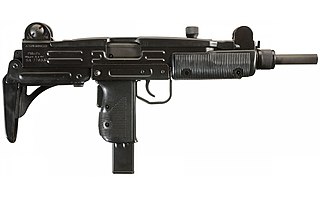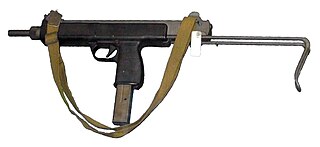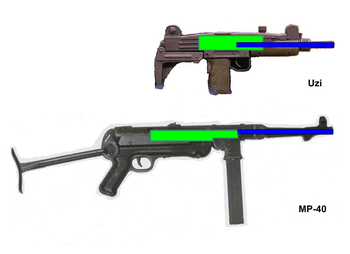
A firearm is any type of gun that uses an explosive charge and is designed to be readily carried and used by an individual. The term is legally defined further in different countries.

A machine pistol is an autoloading pistol capable of fully automatic fire, including stockless handgun-style submachine guns. The term is a calque of Maschinenpistole, the German word for submachine guns.

A submachine gun (SMG) is a magazine-fed automatic carbine designed to fire handgun cartridges. The term "submachine gun" was coined by John T. Thompson, the inventor of the Thompson submachine gun, to describe its design concept as an automatic firearm with notably less firepower than a machine gun. As a machine gun must fire rifle cartridges to be classified as such, submachine guns are not considered machine guns.

The Uzi is a family of Israeli open-bolt, blowback-operated submachine guns and machine pistols first designed by Major Uziel "Uzi" Gal in the late 1940s, shortly after the establishment of the State of Israel. It is one of the first weapons to incorporate a telescoping bolt design, which allows the magazine to be housed in the pistol grip for a shorter weapon.

In firearms terminology, an action is the functional mechanism of a breech-loading firearm that handles the ammunition cartridges, or the method by which that mechanism works. Actions are technically not present on muzzleloaders, as all those are single-shot firearms with a closed off breech with the powder and projectile manually loaded from the muzzle. Instead, the muzzleloader ignition mechanism is referred to as the lock.

The STEN is a British submachine gun chambered in 9×19mm which was used extensively by British and Commonwealth forces throughout World War II and post war including the Korean War. The Sten was a simple design with very low production cost for mass production to meet demand for submachine guns.

The Military Armament Corporation Model 10, officially abbreviated as "M10" or "M-10", and more commonly known as the MAC-10, is a compact, blowback operated machine pistol/submachine gun that was developed by Gordon B. Ingram in 1964. It is chambered in either .45 ACP or 9mm. A two-stage suppressor by Sionics was designed for the MAC-10, which not only abates the noise created but makes it easier to control on full automatic.

The PM-84 Glauberyt is a Polish submachine gun. It is a personal weapon intended for combat and self-defence at ranges up to 150 m with single shot or fully automatic fire mode. It features a compact design, minimum overall dimensions, small weight, very good accuracy, and fire stability. It is designed for heavy weapons platoons personnel and reconnaissance detachments, special anti-terrorist and police troops.

A firearm is said to fire from an open bolt if, when ready to fire, the bolt and working parts are held to the rear of the receiver, with no round in the chamber. When the trigger is actuated, the bolt travels forward, feeds a cartridge from the magazine or belt into the chamber, and fires that cartridge in the same movement. Like any other self-loading design, the action is cycled by the energy released from the propellant, which sends the bolt back to the rear, compressing the mainspring in readiness for firing the next round. In an open-bolt gun firing semi-automatically, the bolt is caught and held at this point by the sear after each shot; and in automatic open-bolt fire, it's caught and held in this manner whenever the trigger is released. In contrast to this, in closed-bolt guns, the trigger and sear do not affect the movement of the bolt directly.
Blowback is a system of operation for self-loading firearms that obtains energy from the motion of the cartridge case as it is pushed to the rear by expanding gas created by the ignition of the propellant charge.

The PM-63 RAK is a Polish 9×18mm submachine gun, designed by Piotr Wilniewczyc in cooperation with Tadeusz Bednarski, Grzegorz Czubak and Marian Wakalski. The RAK combines the characteristics of a self-loading pistol and a fully automatic submachine gun.

The CZ Model 23/25 was perhaps the best known of a series of Czechoslovak designed submachine guns introduced in 1948. There were four generally very similar submachine guns in this series: the Sa 23, Sa 24, Sa 25, and Sa 26. The primary designer was Jaroslav Holeček, chief engineer of the Česká zbrojovka Uherský Brod arms factory.
The BXP is a 9×19mm submachine gun developed by Andries Piek, with the fully automatic version finalised in 1978, and the semi-automatic version for civilians coming later in 1984. Due to an international arms embargo against South Africa, South Africans designed and manufactured some weapons as a small firearms industry developed locally. The BXP was one of these locally designed and developed firearms, and is considered the final stage of development of the line of hand machine carbines that started with the LDP in Rhodesia and the Kommando in South Africa. Produced originally by the South African company Milkor (Pty) Ltd, its name 'BXP' stands for 'Blowback eXperimental Parabellum', hinting both at its operating mechanism as well as its caliber. The original automatic version of the BXP was intended for use by South African law enforcement, including the South African Police, the Correctional Services, and the specialised airport security unit based at the then Jan Smuts International Airport, Johannesburg.

The Steyr MPi 69 is a 9×19mm submachine gun of the late 20th century made by the Austrian firm Steyr.
The Ruger MP9 is a 9×19mm submachine gun/machine pistol introduced by Sturm, Ruger & Co. in 1995. The MP9 was designed by Uziel Gal, designer of the Uzi.
The MCEM-2 was a prototype submachine gun, which never saw widespread production, but was one of the first submachine guns to combine a wrap-around bolt and magazine in pistol grip, features later copied in the Czechoslovak Sa vz. 23, Israeli Uzi, among others. The MCEM-2 was the second prototype in a line of experimental submachine guns designed in Britain in 1944. It was envisaged as a possible replacement for the STEN submachine gun then in service. Jerzy Podsedkowski, a Polish constructor who worked on the Vis and Mors and who fled from occupied Poland to Britain, developed the MCEM-2. It is believed that prototypes of MCEM-2 were made before the end of WW2, and its derivatives MCEM-4 and MCEM-6 were tested soon after the war. The latter modifications differed mostly in adoption of the rate-reducing mechanism, incorporated into the trigger unit; the rate of fire therefore was decreased from 1000 to 600 rounds per minute. Nevertheless, neither prototype was found suitable for adoption, and several years later the British army adopted a more conventional submachine gun, the Sterling-Patchett.

The KRISS Vector is a series of weapons based upon the parent submachine gun design developed by the American company KRISS USA, formerly Transformational Defense Industries (TDI). They use an unconventional delayed blowback system combined with in-line design to reduce perceived recoil and muzzle climb, invented by French engineer Renaud Kerbrat.

The FMK-3 is a selective fire blowback-operated submachine gun of Argentinian origin designed by Fabricaciones Militares in 1974. Around 30,000 were produced for the Argentinian military by 1991.
Recoil operation is an operating mechanism used to implement locked-breech autoloading firearms. Recoil operated firearms use the energy of recoil to cycle the action, as opposed to gas operation or blowback operation using the pressure of the propellant gas.

The SIG MPX is a gas-operated submachine gun designed and manufactured by SIG Sauer, and is primarily chambered in 9×19mm Parabellum. It is a gas-operated firearm featuring a closed, rotating bolt. These design features, rare in submachine guns, were chosen to enhance the safety of the user and to have a more reliable firearm. It was designed in 2013 and was released to the general public in 2015. It features the SIG Sauer short stroke push-rod gas system to reduce the recoil and improve the reliability of the weapon.















